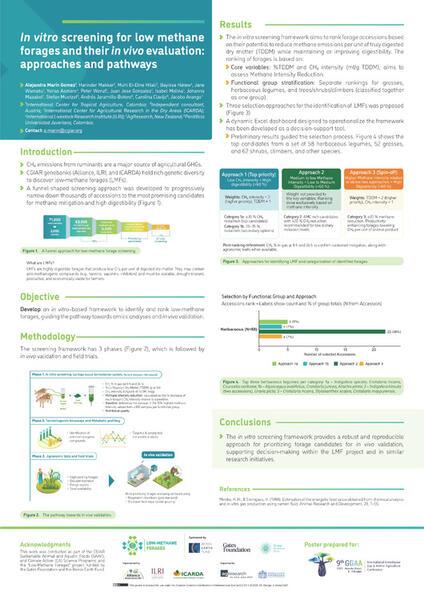
Reducing methane (CH₄) emissions from livestock systems is critical for mitigating climate change, especially in the Global South, where enteric CH₄ accounts for a significant proportion of livestock-related emissions. To address this challenge, three CGIAR Centres (listed in the authors’ affiliations) have initiated a project to screen ~10% of 71,000 forage germplasm accessions, focusing on legumes and grasses, to identify low CH₄ forages (LMFs). LMFs are defined as highly digestible forages that produce low levels of CH₄ per unit of digested dry matter and may contain anti-methanogenic compounds (AMCs) such as tannins (polyphenols), saponins, hydrogen sinks, and inhibitors, among others. Cosmopolitan forage species will be targeted. The forages should consistently reduce CH₄ emissions by at least 12%, should be drought-tolerant, scalable, easy to cultivate, economically viable and capable of enhancing livestock productivity while reducing environmental and ecological impacts. Guided by this definition, a stepwise screening approach based on a decision matrix was developed to transition promising forages from in vitro evaluation to in vivo validation. The evaluation of LMFs follows a systematic three-phase framework: Phase 1: in vitro gas production analysis using the syringe method evaluates forage accessions based on three key indicators: truly digested dry matter (TDDM, %), CH₄ production (CH₄, % in gas), and CH₄ intensity (CH₄/unit of TDDM, ml/g). A decision matrix prioritizes forages with high TDDM, low CH₄, and low CH₄ intensity for advancement to Phase 2. Phase 2: Metabolic profiling, including tannin and saponin bioassays, confirms the presence of AMC. Thresholds for high, medium, and low levels of CH₄ emission in the matrix are being defined based on a pilot study with 150 forage species and cultivars from gene banks and supported by existing literature. These thresholds are expected to vary among legumes and grasses as well as between tropical and temperate forages and will be finalized based on the evidence gathered in phase 1. Phase 3: Selected forages will undergo in vivo validation using respiration chambers to measure CH₄ emissions under real feeding and environmental conditions. The decision matrix continues to guide the process, prioritizing forages with optimal CH₄ mitigation properties and identifying supplementation strategies. Ongoing activities will finalize Phases 1 and 2, and key results including decision matrix thresholds will be shared at the conference. Two approaches for implementation of LMFs in the production systems, termed as evolutionary and revolutionary area proposed. Evolutionary approach: Refines existing diets with locally available LMFs, targeting about 15% increase in productivity and 15-20% decrease in CH₄ emission. Revolutionary approach: Introduces novel or gene-edited LMFs, targeting >25% increases in both productivity and CH₄ emission reduction, but requiring greater adaptation and introduction efforts. All scaling options should consider ease of propagation (seed or vegetative), adaptability to local climate and soils, and potential for high yields, to ensure successful field implementation. It represents a critical step towards developing climate-smart livestock systems in the Global South where forage-based systems dominate livestock production and make forages to be the key delivery mechanism of enteric CH4-reducing compounds to ruminants.

